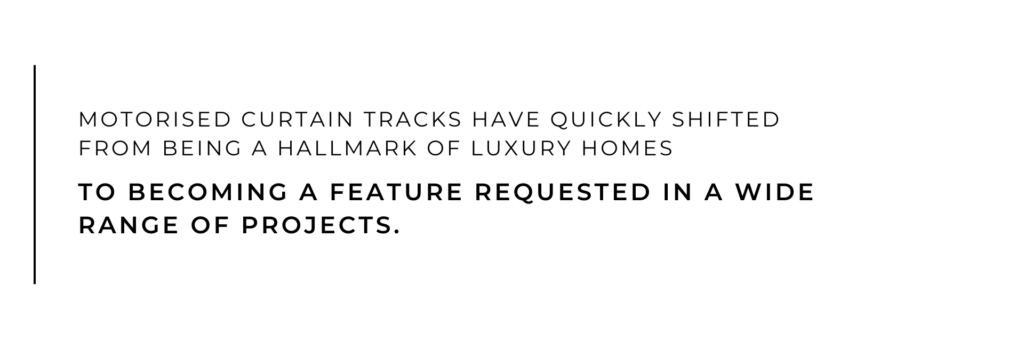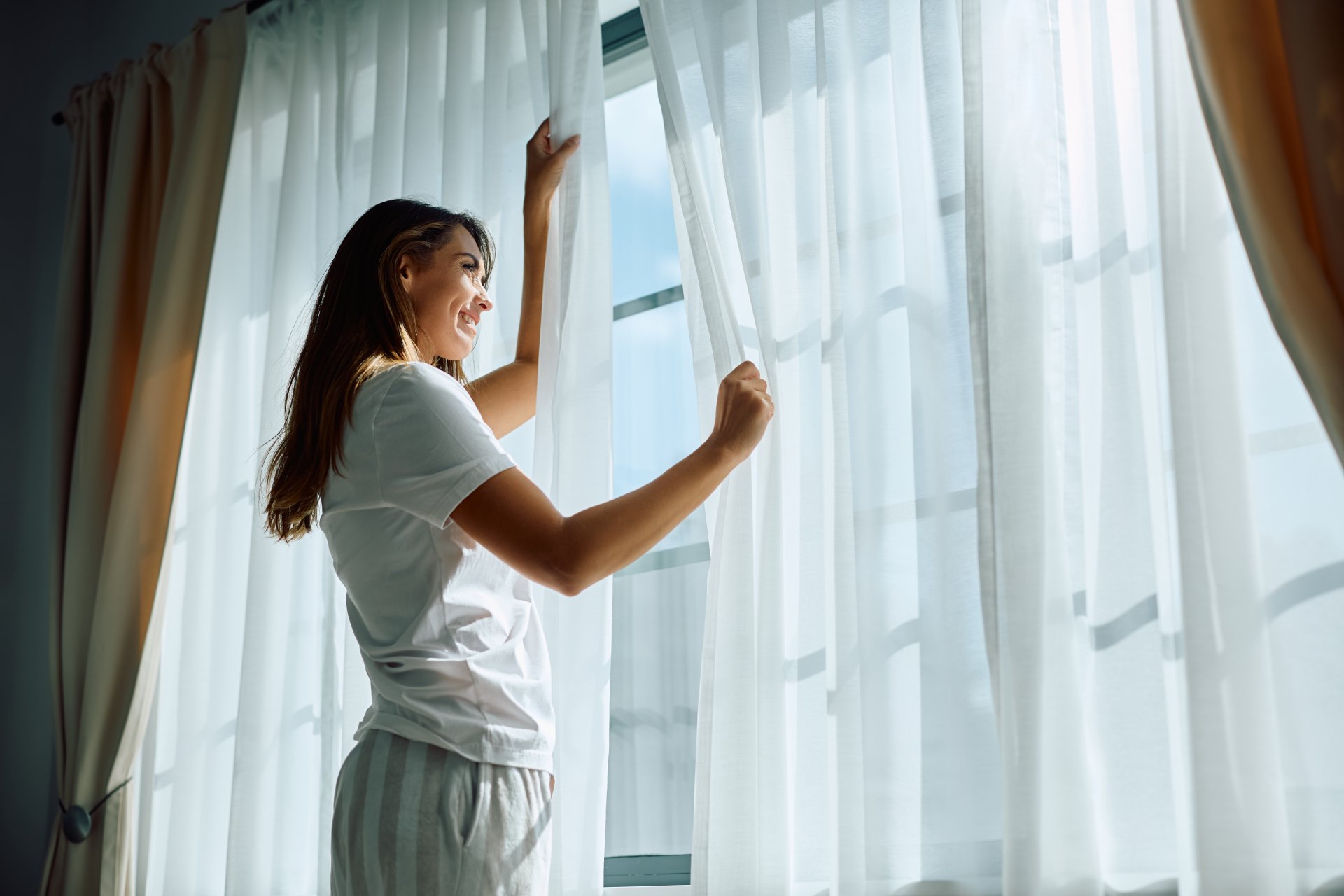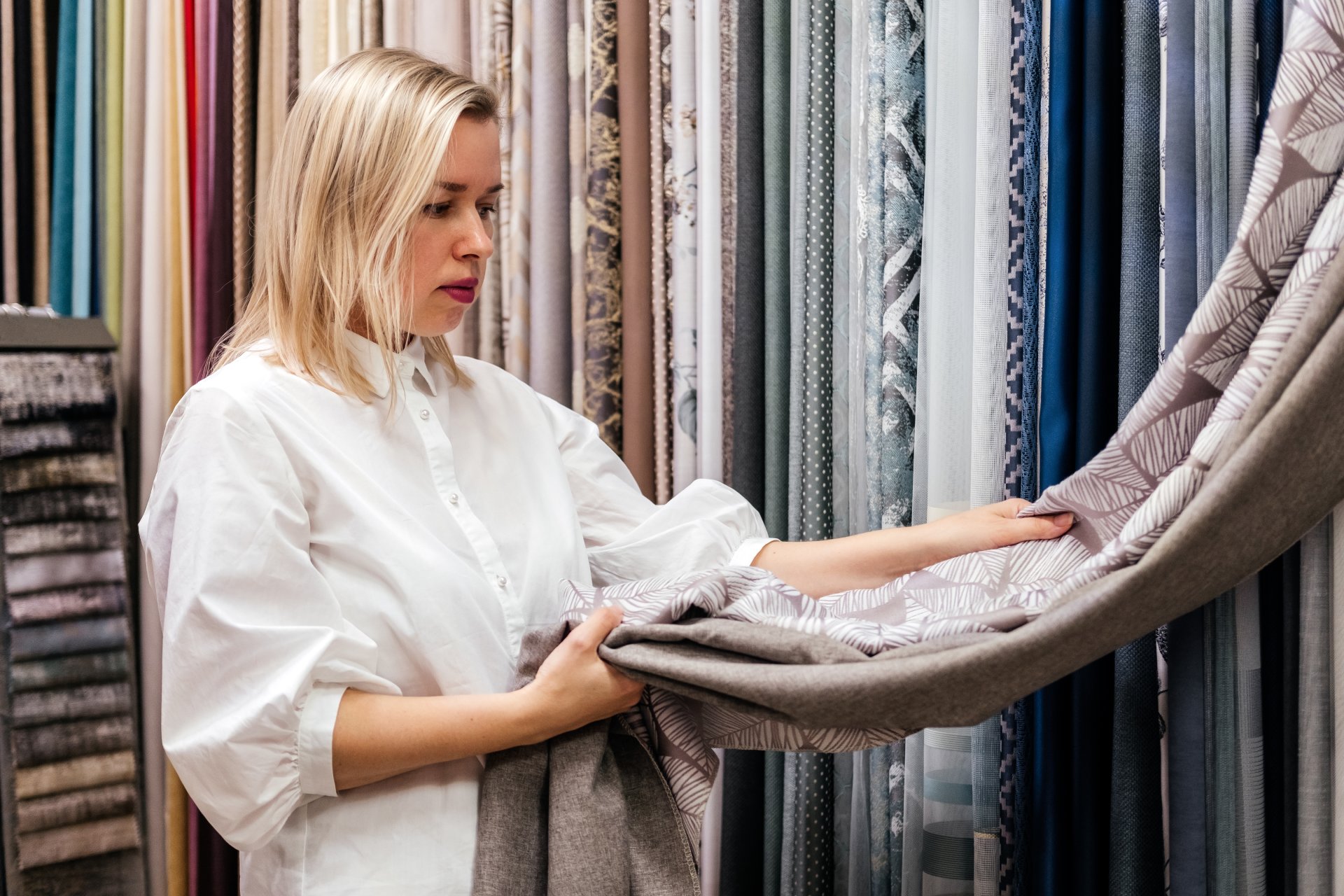Curtain tracks are often one of the last details specified in a project, but they can significantly affect how a space functions and feels. Choosing between manual or motorised systems is not simply a matter of cost or preference. The decision should take into account client needs, building design, project scale, and the long-term performance of the installation.
This article explores the advantages and limitations of both custom-made manual and motorised tracks, offering practical insights for interior designers, architects, building designers, and curtain installers working across residential and commercial settings.

The Role of Curtain Tracks in Design
Curtain tracks do more than support fabric. They determine how smoothly curtains operate, influence the way fabric drapes, and can even change how light enters a room. A poorly specified track can undermine an otherwise carefully considered design. In contrast, the right system can support the daily use of a space while enhancing comfort, energy efficiency, and even accessibility.
Design professionals need to consider how much handling a curtain will endure, whether the client wants seamless integration with automation, and how the chosen system fits with the project’s overall performance requirements.
Manual Curtain Tracks: Where They Excel
Manual curtain tracks continue to play a central role in both residential and commercial projects. While automation attracts much attention, manual systems offer reliability, affordability, and flexibility that make them suitable for a wide range of applications. They are simple to specify, easy to install, and, when chosen correctly, can perform exceptionally well for many years.
Advantages of Manual Tracks
- Affordability: With no motors, wiring, or additional control devices, manual systems are often the most cost-effective choice, keeping budgets under control without sacrificing quality.
- Ease of installation: These tracks can be installed quickly, requiring minimal planning and no specialised electrical work, making them attractive for fast-turnaround projects.
- Reliability: With fewer moving parts, manual systems tend to require little upkeep and can provide consistent operation over long periods.
- Flexibility: Manual tracks are highly adaptable and can be customised to fit bay windows, angled openings, or irregular architectural features.
- Discretion: Many manual systems can be recessed into ceilings or fitted with low-profile designs that allow the focus to remain on the curtain fabric.
Best Applications for Manual Systems
- Residential homes where curtains are operated daily but do not face extreme use.
- Heritage projects where modern automation may be difficult to integrate without compromising period detailing.
- Small hospitality venues where reliable, straightforward curtain operation is sufficient.
- Budget-conscious developments where dependable function is needed at a lower overall project cost.
Motorised Curtain Tracks: Growing Demand
Motorised curtain tracks have quickly shifted from being a hallmark of luxury homes to becoming a feature requested in a wide range of projects. Improvements in technology, the availability of quieter motors, and straightforward compatibility with popular automation systems have broadened their appeal. They are now seen not only as a premium option but also as a practical solution for modern living and working environments.
Advantages of Motorisation
- Convenience: Curtains can be operated with a handheld remote, a smartphone app, or linked into a central building management system, offering effortless daily use.
- Accessibility: Particularly valuable for clients with reduced mobility or where windows are positioned high or behind furniture, removing the need for manual adjustment.
- Consistency: Curtains open and close at a uniform speed and tension, reducing wear on both the track and the fabric while maintaining a polished appearance.
- Integration: Systems can be connected to smart home technology or commercial building platforms, enabling features such as scheduling, security settings, and energy-efficient light control.
- Prestige: Motorisation continues to signal quality and sophistication, often adding perceived value to a property or commercial development.
Best Applications for Motorised Systems
- High-end residential projects where seamless integration with smart systems enhances daily comfort.
- Large commercial venues such as hotels, auditoriums, and boardrooms that require frequent or coordinated curtain operation.
- Healthcare and aged care facilities where reducing manual handling supports hygiene and accessibility.
- Energy-conscious developments where linking curtains to sensors helps regulate daylight, heat, and cooling needs.

Comparing Performance: Key Considerations
When guiding clients through the choice between manual and motorised curtain tracks, it is important to look beyond cost alone. Several performance factors influence the suitability of each system for a specific project.
Frequency of use should be one of the first considerations. Curtains in a busy hotel lobby or a conference centre will be opened and closed many times a day. In these cases, motorisation prevents wear on the track and fabric by ensuring smooth and consistent movement. In contrast, a spare bedroom or private lounge with occasional use may not require the same investment.
Fabric weight is another practical factor. Heavy drapes, interlined curtains, or layered treatments can feel awkward to operate manually. Motorised systems handle the extra weight effortlessly, maintaining a fluid motion and prolonging the life of the fabric.
The function of the room also plays a major role. A boardroom or theatre may rely on blackout conditions at the push of a button, while a residential bedroom or study may be well served with a straightforward manual track.
Accessibility cannot be overlooked. Tall windows, hard-to-reach installations, or clients with reduced mobility often find motorisation the more practical and inclusive option.
On the subject of maintenance, manual tracks generally require little attention, while motorised systems may need periodic servicing of motors or remotes. However, they offer an additional advantage in energy management, as integration with sensors allows curtains to adjust automatically, regulating light and temperature to support building efficiency.
Design Integration and Aesthetics
Tracks are not only functional but also part of the overall interior design. Manual systems can be discreet, especially ceiling-recessed tracks that create a seamless look. Motorised systems, however, allow for hidden operation and can support large expanses of fabric that might otherwise overwhelm a manual system.
Designers should consider how visible the track will be, whether the project calls for a minimalist effect, and how the curtain headings interact with the chosen system. Wave fold or S-fold styles, for example, are often used with motorisation to create a uniform finish.
Installation Factors
The installation stage can determine the long-term performance of any track system.
- Manual tracks: Typically require fewer installation steps and less pre-planning. They are a strong choice when project timelines are tight.
- Motorised tracks: Need more preparation, including wiring, control systems, and integration with automation platforms. Collaboration between designers, electricians, and installers is essential to achieve seamless operation.
For large-scale projects such as hotels, considering installation sequencing early in the design phase prevents costly modifications later.
Cost Considerations
Cost is often a deciding factor, but it should be framed in terms of long-term value rather than initial spend.
- Manual systems: Lower upfront cost and minimal servicing. Best for straightforward residential and small commercial projects.
- Motorised systems: Higher upfront investment but offer added value in convenience, accessibility, and potential energy savings.
For commercial clients, the return on investment often comes from reduced energy use, improved user experience, and the ability to differentiate a property through premium features.

Safety and Compliance
In Australia, compliance with safety standards is essential. Corded blinds and tracks have strict requirements under ACCC regulations to prevent hazards for children. Motorised tracks can eliminate cords entirely, making them a safer choice for childcare centres, aged care facilities, and family homes.
Additionally, many motorised tracks are tested for durability and performance in line with international standards. Designers specifying systems for public buildings should confirm that products meet relevant fire safety, electrical, and mechanical standards.
Sustainability Considerations
Sustainability is influencing product selection in both residential and commercial design. Motorised tracks can contribute by reducing energy consumption. For example, automated curtains that respond to daylight sensors can cut cooling loads in summer and retain heat in winter.
Manual tracks, while less sophisticated, still have a role in sustainable design by offering long-lasting, low-maintenance performance with minimal resource use. The choice may depend on whether energy efficiency or simplicity is the client’s priority.
Future Trends in Curtain Tracks
The trend toward automation is unlikely to slow. With growing adoption of smart home technology and building automation in Australia, motorised systems are increasingly expected in premium developments. Wireless options are reducing installation complexity, while quieter motors are enhancing user experience.
At the same time, there will always be a place for manual systems. Heritage projects, cost-sensitive developments, and clients who prefer straightforward solutions will continue to rely on manual tracks.
Helping Clients Make the Right Choice
Design professionals are often the key advisors guiding clients through the selection process. Providing clear comparisons of manual and motorised systems helps clients understand the long-term implications of their decision. Demonstrating real examples, such as a motorised track in a hotel ballroom or a manual track in a heritage home, can help clients visualise outcomes.
By framing the choice around function, performance, and integration rather than price alone, professionals can ensure curtain track systems enhance both the design and the daily experience of the space.
Partnering with a Leading Custom Curtain Track Supplier for Precision Results
Selecting between manual and motorised curtain tracks is not a one-size-fits-all decision. Each project has unique demands shaped by the client’s lifestyle, the building’s function, and the design vision.
At MAC Window Fashions, we support interior designers, architects, and curtain installers with Australian Made Certified custom curtains and precision-engineered custom curtain track systems. From sleek manual designs to advanced motorised options compatible with Somfy automation, our products are built to meet both aesthetic and functional requirements.Whether you are working on a luxury residence, a hotel refurbishment, or a commercial fit-out, we can help you deliver a solution that balances practicality, style, and durability. To learn more, please contact us today, find a MAC retail partner, or become a MAC partner.




